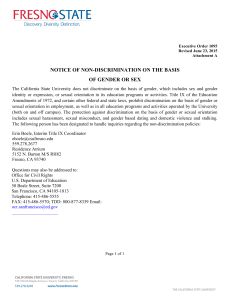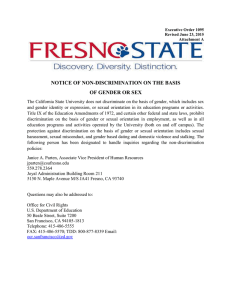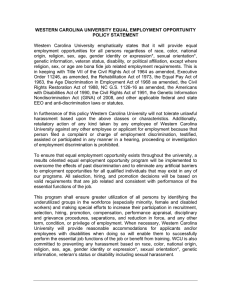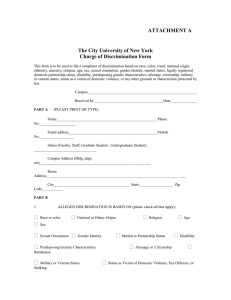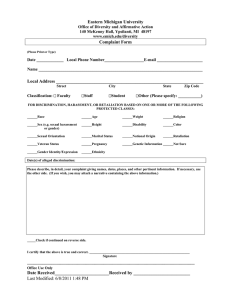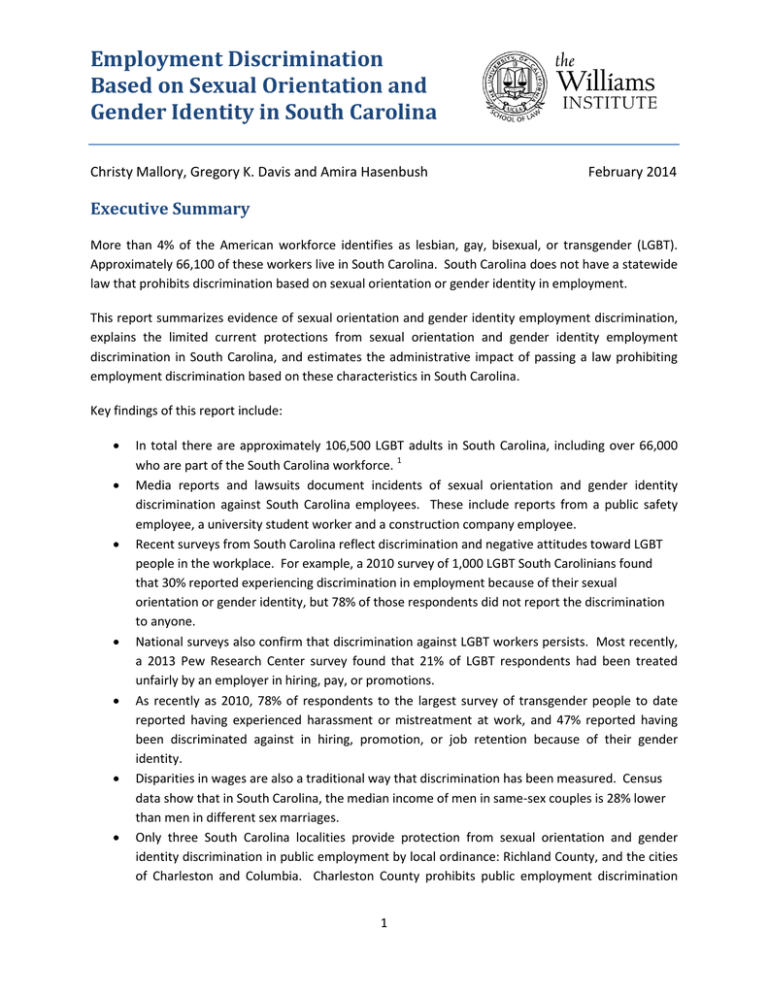
Employment Discrimination
Based on Sexual Orientation and
Gender Identity in South Carolina
Christy Mallory, Gregory K. Davis and Amira Hasenbush
February 2014
Executive Summary
More than 4% of the American workforce identifies as lesbian, gay, bisexual, or transgender (LGBT).
Approximately 66,100 of these workers live in South Carolina. South Carolina does not have a statewide
law that prohibits discrimination based on sexual orientation or gender identity in employment.
This report summarizes evidence of sexual orientation and gender identity employment discrimination,
explains the limited current protections from sexual orientation and gender identity employment
discrimination in South Carolina, and estimates the administrative impact of passing a law prohibiting
employment discrimination based on these characteristics in South Carolina.
Key findings of this report include:
•
•
•
•
•
•
•
In total there are approximately 106,500 LGBT adults in South Carolina, including over 66,000
who are part of the South Carolina workforce. 1
Media reports and lawsuits document incidents of sexual orientation and gender identity
discrimination against South Carolina employees. These include reports from a public safety
employee, a university student worker and a construction company employee.
Recent surveys from South Carolina reflect discrimination and negative attitudes toward LGBT
people in the workplace. For example, a 2010 survey of 1,000 LGBT South Carolinians found
that 30% reported experiencing discrimination in employment because of their sexual
orientation or gender identity, but 78% of those respondents did not report the discrimination
to anyone.
National surveys also confirm that discrimination against LGBT workers persists. Most recently,
a 2013 Pew Research Center survey found that 21% of LGBT respondents had been treated
unfairly by an employer in hiring, pay, or promotions.
As recently as 2010, 78% of respondents to the largest survey of transgender people to date
reported having experienced harassment or mistreatment at work, and 47% reported having
been discriminated against in hiring, promotion, or job retention because of their gender
identity.
Disparities in wages are also a traditional way that discrimination has been measured. Census
data show that in South Carolina, the median income of men in same-sex couples is 28% lower
than men in different sex marriages.
Only three South Carolina localities provide protection from sexual orientation and gender
identity discrimination in public employment by local ordinance: Richland County, and the cities
of Charleston and Columbia. Charleston County prohibits public employment discrimination
1
•
•
•
•
•
based on sexual orientation alone. These local ordinances do not prohibit discrimination in
private employment.
Approximately 82% of South Carolina’s public sector workforce is not covered by a local
ordinance that prohibits public employment discrimination based on sexual orientation, and
approximately 88% of the public sector workforce is not covered by a local ordinance that
prohibits public employment discrimination based on gender identity. None of South Carolina’s
private sector workforce is covered by a non-discrimination ordinance that prohibits
discrimination in private employment.
Even in those localities that have passed ordinances prohibiting discrimination based on sexual
orientation or gender identity, the scope of those protections varies from place to place. Also,
none of the local ordinances are as inclusive as the statewide non-discrimination law, which
prohibits discrimination in private employment.
Private companies may adopt internal non-discrimination policies to improve recruitment and
retention of talented employees, to increase employee productivity and customer satisfaction,
or to attract a larger customer base. Eight of the state’s ten largest employers have internal
corporate policies prohibiting sexual orientation and gender identity discrimination, and four
Fortune 1000 companies with headquarters in South Carolina prohibit sexual orientation
discrimination.
Adding sexual orientation and gender identity to the state’s current non-discrimination law
would result in approximately 31 additional complaints being filed with the South Carolina
Human Affairs Commission each year.
Because the annual number of discrimination complaints filed with the South Carolina Human
Affairs Commission each year varies by many more than 31, the anticipated new complaints
based on sexual orientation and gender identity could likely be absorbed into the existing
system with no need for additional staff and negligible costs. A conservatively high estimate
suggests that enforcement would cost the state approximately $23,000 annually; which
represents 1.4% of the South Carolina Human Affairs Commission’s budget in fiscal year 20112012.
Evidence of Discrimination
Survey Data and Specific Examples of Sexual Orientation and Gender Identity
Discrimination in South Carolina
Research shows the existence of widespread and continuing discrimination against LGBT workers in the
U.S. In response to surveys, LGBT workers consistently report having experienced discrimination, and
non-LGBT people often report having witnessed discrimination against their LGBT co-workers. For
example, a national survey conducted by Pew Research Center in 2013 found that 21% of LGBT
respondents had been treated unfairly by an employer in hiring, pay, or promotions. 2 Additionally, the
nationally representative 2008 General Social Survey found that 37% of gay men and lesbians had
experienced workplace harassment in the last five years, and 12% had lost a job because of their sexual
2
orientation. 3 As recently as 2010, 78% of respondents to the largest survey of transgender people to
date reported having experienced harassment or mistreatment at work, and 47% reported having been
discriminated against in hiring, promotion, or job retention because of their gender identity. 4
Similar statistics have been found in surveys of LGBT individuals in South Carolina. In 2010, SC Equality
surveyed over 1,000 LGBT South Carolinians from 44 of the 46 counties in South Carolina. 5 Thirty
percent of the respondents reported having experienced employment discrimination in hiring, firing or
promotion decisions because of their sexual orientation or gender identity. 6 Despite this level of
discrimination, respondents tended not to report these incidents: 78% did not report the discrimination
to anyone and only 13% reported it to a human resources department. 7 These levels of discrimination
were reported despite 57% of respondents stating that they were not very open about their sexual
orientation or gender identity at work, and only 50% reporting being open with their family. 8
Employment discrimination against LGBT people has also been documented in court cases, state and
local administrative complaints, complaints to community-based organizations, academic journals,
newspapers, books, and other media. Additionally, a number of federal, state, and local administrative
agencies and legislative bodies have acknowledged that LGBT people have faced widespread
discrimination in employment. 9
Several recent instances of employment discrimination against LGBT people in South Carolina have been
documented in the media, court cases, and reports to legal organizations:
•
•
•
•
In May 2013, a transgender public safety employee of Cayce, South Carolina filed suit against
the city for forcing him to wear a woman’s bulletproof vest following his gender reassignment
surgery. 10 According to his complaint, this act by the city was only one in a series of moves to
embarrass or subordinate him after he informed his superiors of his intention to transition,
which led to reassignment and a pre-textual firing. 11
In 2013, a student worker was removed from his university work study position as a resident
assistant when he began posting YouTube videos about being an openly gay Christian. 12 He was
told that parents might find his videos online and be uncomfortable with their children having a
gay resident assistant. 13
In 2008, a popular human resources website reported that a South Carolina worker’s colleagues
constantly abused him and called him names based on his sexual orientation. 14 When he
complained to his supervisors, they fired him. 15
In 2007, an employee of a South Carolina-based construction company filed a claim for
intentional infliction of emotional distress against his employer after allegedly suffering constant
verbal harassment over his perceived homosexuality. 16
Wage Inequity
Census data show that men in same-sex couples in South Carolina earn less than men married to
different-sex partners. On average, men in same-sex couples in South Carolina earn $27,417 each year,
3
significantly less than the $42,810 for men married to different-sex partners. 17 The median income of
men in same-sex couples in South Carolina is $24,000, or 28% less than that of married men ($33,500). 18
Men with same-sex partners earn lower wages, despite the fact that they are more likely to have a
college degree than men married to different-sex partners, 19 a comparison that supports the possibility
that people in same-sex couples are not treated equally by employers. A 2009 study indicated that the
wage gap for gay men is smaller in states that implement non-discrimination laws, suggesting that such
laws reduce discrimination against LGBT people. 20
Women in same-sex couples earn less than married men as well as men in same-sex couples. 21 Women
in same-sex couples in South Carolina earn an average of $26,569 per year (with a median of $20,000),
which is more than married women, whose earnings average $23,173 (with a median of $20,000). 22
These findings are not unique to South Carolina. Analyses of national data consistently find that men in
same-sex couples and gay men earn 10-32% less than similarly qualified men who are married to
different-sex partners, or men who identify as heterosexual. 23 Surveys of transgender people find that
they have high rates of unemployment and very low earnings. 24
Current Protections from Discrimination
South Carolina does not have a statewide law that prohibits discrimination based on sexual orientation
and/or gender identity in employment. 25 Efforts were made to pass such a law in the South Carolina
Senate in 2007 and 2009. 26 In late April 2013, the South Carolina House introduced a similar bill, H.B.
4025 where it remains in the Judiciary Committee.27 Through these bills, the South Carolina Legislature
sought to prohibit employment discrimination based on sexual orientation and gender identity by
adding the characteristics to its existing employment discrimination statute, the South Carolina Human
Affairs Law (SC-HAL). 28
The South Carolina Human Affairs Law
Currently, the SC-HAL prohibits employment discrimination by most employers with 15 or employees 29
on the bases of race, religion, color, sex (including pregnancy) 30, age, national origin (including
ancestry) 31, and disability status. 32 The SC-HAL applies to both public sector and private sector
employers. 33
The SC-HAL exempts religious organizations from coverage to the extent that such organizations may
give employment preference to “individuals of a particular religion to perform work connected with the
carrying on by the [religious organization] of its activities.” 34 Religious organizations include a “religious
corporation, association, educational institution, or society.” 35
The Human Affairs Commission (the Commission) enforces the SC-HAL. The Commission has the power
to intake, investigate, and prosecute specific instances of employment discrimination, and to study and
4
report on discrimination statewide. 36 An employee must file a complaint with the Commission within
180 days after the discriminatory practice occurred. 37
During the fiscal year 2011-2012, the Commission received 1,028 new complaints of employment
discrimination, resulting in 765 final actions through mediations and suits. 38 The Commission also does
intake and mediations regarding claims of housing discrimination, although this represents a small
number of the Commissions complaints each year (64 in fiscal year 2011-2012). 39
Local-Level Protections from Discrimination
Three localities in South Carolina prohibit public sector employment discrimination based on sexual
orientation and gender identity by local ordinance: Richland County 40 and the cities of Charleston 41 and
Columbia. 42 Charleston County prohibits public sector employment based on sexual orientation alone. 43
Additionally, North Charleston prohibits discrimination based on sexual orientation and gender identity
in housing, 44 and Folly Beach prohibits discrimination based on sexual orientation in public
accommodations. 45 None of the LGBT-inclusive local ordinances prohibit discrimination in private
employment. Approximately 82% of South Carolina’s public sector workforce is not covered by a local
ordinance that prohibits public employment discrimination based on sexual orientation, and
approximately 88% of the public sector workforce is not covered by a local ordinance that prohibits
public employment discrimination based on gender identity. 46
Even within those localities that have non-discrimination ordinances, the scope of the protection varies
from place to place. For example, while Richland 47 County, Columbia, 48 Charleston 49 and North
Charleston 50 include both sexual orientation and gender identity in their ordinances and policies, Folly
Beach 51 and Charleston County 52 do not explicitly provide any protection against discrimination based
on gender identity. Additionally, Folly Beach’s ordinance only applies to public accommodations, 53 and
North Charleston’s ordinance only applies to housing, 54 while Richland County covers public
employment and public accommodations, 55 and Columbia 56 and Charleston 57 have ordinances and
policies that cover public employment, public accommodations and housing. Finally, none of the local
ordinances provide as much protection as the statewide law, which also prohibits discrimination in
private employment. 58
Private Company Non-Discrimination Policies
Private companies adopt internal policies prohibiting discrimination based on sexual orientation and
gender identity for a variety of reasons including improved recruitment and retention of talented
employees, increasing employee productivity and customer satisfaction, and attracting a larger
customer base. 59 One study of corporate motivations behind adopting workplace non-discrimination
policies found that 53% of the top companies in the U.S. with LGBT-supportive policies had adopted the
policies for economic reasons. 60
5
Academic research has found that LGBT-supportive corporate policies are linked to positive businessrelated outcomes, including greater job commitment, improved workplace relationships, increased job
satisfaction, and improved health outcomes among LGBT employees. 61 For example, a 2006 national
poll found that 89% of LGBT respondents and 72% of non-LGBT respondents reported that when
deciding where to work, it was important that an employer have a written non-discrimination policy that
includes race, ethnicity, sex, religion, age, sexual orientation and disability. 62 Research also suggests
that employers limit their available talent pool by screening out applicants based on their sexual
orientation. One study found that the rate of screening out gay male applicants was twice as high in
regions without sexual orientation non-discrimination laws. 63
Additionally, LGBT-supportive workplace policies can expand opportunities to secure potentially
lucrative government contracts for corporate employers. A 2011 study found that 68 local governments
had laws requiring contractors to have LGBT-inclusive non-discrimination policies. 64 A number of states
have similar laws that apply to state government contracts. 65 Without such policies, companies would
not be eligible to bid for contracts with these state and local governments.
Some of South Carolina’s top companies and employers have adopted internal corporate policies that
prohibit sexual orientation and gender identity discrimination. According to the Human Rights
Campaign, at least 12 companies headquartered in South Carolina prohibit discrimination based on
sexual orientation, including four Fortune 1000 companies: Domtar Corp., SCANA Corp., ScanSource,
Inc., and Sonoco Products Company. 66 Eight of South Carolina’s top ten employers, as ranked in the
Chamber of Commerce’s Big 50 67 have non-discrimination policies that explicitly include both sexual
orientation and gender identity: Walmart Stores Inc., 68 Greenville Health System, 69 Palmetto Health, 70
Blue Cross Blue Shield of South Carolina, 71 Food Lion, 72 the Boeing Company, 73 Lowe’s Companies, Inc. 74
and Wells Fargo and Company. 75 Additionally, some public universities provide sexual orientation
discrimination protections, including the University of South Carolina system, 76 Clemson University 77 and
the Citadel. 78
Administrative Impact
Complaint Estimate
Despite the persistence and pervasiveness of employment discrimination against LGBT people, studies
show that enforcing sexual orientation and gender identity provisions in non-discrimination laws has
only a minimal burden on state agencies. Complaints of sexual orientation discrimination are filed by
LGBT people at approximately the same rate as complaints of race and sex discrimination are filed by
people of color and women, respectively. 79 However, because the LGBT population is so small, the
absolute number of sexual orientation and gender identity complaints filed under state nondiscrimination laws is very low. 80
We estimate that approximately 31 complaints of sexual orientation or gender identity discrimination
would be filed with the South Carolina Human Affairs Commission each year. To reach this estimate, we
6
drew on Gallup polling data and Census data from South Carolina to estimate the size of the LGBT
workforce in the state, and applied a national sexual orientation and gender identity complaint rate to
that population. We have previously used this methodology to estimate the number of complaints that
would be filed on the basis of sexual orientation and gender identity in other states, including Missouri,
Ohio, Pennsylvania, South Dakota, Texas, Utah, and West Virginia. 81
Results from a 2012 Gallup poll show that 2.9% of people in South Carolina identify as LGBT. 82 Applying
this percentage to the number of people in South Carolina’s workforce (2,280,559 83) indicates that
there are 66,136 LGBT workers in South Carolina.
Next, we applied the rate of complaints filed on the basis of sexual orientation or gender identity to the
number of LGBT workers in South Carolina to determine how many complaints will be filed annually if
these characteristics are added to the employment non-discrimination law. We used the national
average complaint rate from a 2008 study that analyzed administrative complaint data from 17 states
that prohibited sexual orientation discrimination at that time. 84 The study found that across these
states, the average rate of complaints filed on the basis of sexual orientation was 4.7 per 10,000 LGB
workers. 85 There is not sufficient data to make a similar calculation of the average rate of complaints
file on the basis of gender identity. 86 Therefore, we assume that this rate is also 4.7 per 10,000
transgender workers.
Applying the national complaint rate (4.7 per 10,000 LGBT workers) to the number of LGBT workers in
South Carolina (66,136) suggests that 31 complaints of sexual orientation and gender identity
discrimination would be filed annually if these characteristics were added to the state’s employment
non-discrimination law.
Cost of Enforcement
Using Information from the most recent Accountability Report of the South Carolina Human Affairs
Commission (fiscal year 2011-2012), we can estimate the cost associated with handling the additional 31
complaints that would be filed if sexual orientation and gender identity were added to the South
Carolina Human Affairs Law.
In fiscal year 2011-2012, the South Carolina Human Affairs Commission received 1,028 employment
discrimination complaints and 64 housing discrimination complaints, or 1,092 in total. 87 The
Commission operated on a budget of $1,634,478.88 In previous years, the Commission broke down the
budget into five major program areas and an “other” category. The five major program areas were:
administration (to provide administrative direction, control and supervision of the agency); consultive
services (to provide technical services, training, equal opportunity reporting and community relations
consulting services); compliance programs (to provide intake, referral, investigative, mediation and
compliant resolution services); employer contributions; and non-recurring appropriation (to provide
non-recurring support for agency personnel). 89 Most likely, “compliance programs” is the only area that
would be noticeably impacted by more complaints being filed. It is unlikely that the amount spent on
7
administration services would change, or that consultive services would be burdened by the addition of
two personal characteristics (sexual orientation and gender identity) to an already existing law. Once
these characteristics are integrated into the Commission’s paperwork and trainings, there should be no
ongoing expenses associated with them in these areas.
Based on these assumptions, we can calculate the impact of adding sexual orientation and gender
identity to the state’s non-discrimination law by determining the average cost of enforcing a complaint,
and then multiplying the cost by the number of complaints we expect to be filed on the basis of sexual
orientation and gender identity. In the 2011-2012 fiscal year, 46.5% of the Commission’s budget went
to the compliance programs area. 90 Based on this figure, $760,032 was spent on compliance programs
in 2011-2012.
In the fiscal year 2011-2012, the South Carolina Human Affairs Commission received 1,028 employment
discrimination complaints and 64 housing discrimination complaints, or 1,092 in total. 91 Dividing the
estimated compliance programs budget by the number of complaints received indicates that
enforcement costs an average of $740 per complaint filed. Based on this assumption, if 31 complaints
of sexual orientation and gender identity discrimination were filed each year, it would cost the state
approximately $23,000 to enforce them.
This estimate is likely to be conservatively high. Annual fluctuations in the number of complaints filed
with the Commission are greater than 31. From fiscal year 2008-2009 to fiscal year 2011-2012, the
number of complaints filed from year to year varied by 476, on average. There was no corresponding
impact on the Commission’s budget. This information suggests that the additional complaints could be
absorbed into the existing budget with no noticeable impact on the budget.
Fiscal Year
2008-2009 92
2009-2010 93
2010-2011 94
2011-2012 95
Number of Complaints Handled
1,797
1,184
730
1,092
Budget
$2,540,060
$1,420,817
$1,837,359
$1,634,478
Conclusion
Documented evidence shows that LGBT people face employment discrimination across the country,
including in South Carolina. There is currently no law that prohibits employment discrimination based
on sexual orientation or gender identity in South Carolina. Adding these characteristics to the South
Carolina Human Affairs Law would provide protection from discrimination to approximately 66,000 LGBT
workers in the state. Based on data from other state administrative enforcement agencies, we estimate
that approximately 31 complaints of sexual orientation or gender identity employment discrimination
would be filed in South Carolina annually if the law were amended. A conservatively high estimate
based on data from the South Carolina Human Affairs Commission suggests that it would cost the state
approximately $23,000 to enforce these complaints each year; which represents 1.4% of the South
8
Carolina Human Affairs Commission’s budget in fiscal year 2011-2012. This amount represents a small
percentage of the Commission’s 2011-2012 budget; and given fluctuations in the annual budget and the
number of complaints filed, it is likely that 31 additional complaints would have no noticeable impact on
the Commission’s budget.
9
About the Williams Institute
The Williams Institute on Sexual Orientation and Gender Identity Law and Public Policy at UCLA
School of Law advances law and public policy through rigorous, independent research and
scholarship, and disseminates its work through a variety of education programs and media to
judges, legislators, lawyers, other policymakers and the public. These studies can be accessed at
the Williams Institute website.
For more information
The Williams Institute, UCLA School of Law
Box 951476
Los Angeles, CA 90095‐1476
(310)267‐4382
williamsinstitute@law.ucla.edu
www.law.ucla.edu/williamsinstitute
10
Endnotes
1
These estimates were reached by applying the percentage of people in South Carolina that are LGBT (2.9%) to the
population of South Carolina aged 16 years and older (3,675,075) and the number of people in the South Carolina
labor force (2,280,559), respectively. Gary J. Gates & Frank Newport, LGBT Percentage Highest in D.C., Lowest in
North Dakota, GALLUP, Feb. 15,2013, http://www.gallup.com/poll/160517/lgbt-percentage-highest-lowest-northdakota.aspx; American Community Survey, U.S. Census Bureau, American FactFinder, 2012 ACS Table DP03:
Selected Economic Characteristics, 1-Year Estimates, available at
http://factfinder2.census.gov/faces/tableservices/jsf/pages/productview.xhtml?pid=ACS_12_5YR_DP03.
2
A Survey of LGBT Americans: Attitudes, Experiences and Values in Changing Times, Pew Research Center, June 13,
2013, http://www.pewsocialtrends.org/2013/06/13/a-survey-of-lgbt-americans/.
3
BRAD SEARS & CHRISTY MALLORY, WILLIAMS INST., DOCUMENTED EVIDENCE OF EMPLOYMENT DISCRIMINATION & ITS EFFECTS ON
LGBT PEOPLE 2 (2011), http://williamsinstitute.law.ucla.edu/wp-content/uploads/Sears-Mallory-Discrimination-July20111.pdf.
4
JAMIE M. GRANT, LISA A. MOTTET, JUSTIN TANIS, JACK HARRISON, JODY L. HERMAN, & MARA KEISLING, INJUSTICE AT EVERY TURN: A
REPORT OF THE NATIONAL TRANSGENDER DISCRIMINATION SURVEY 51 (2011),
http://www.thetaskforce.org/downloads/reports/reports/ntds_full.pdf.
5
SC EQUALITY, A SURVEY OF SOUTH CAROLINA’S LESBIAN, GAY, BISEXUAL AND TRANSGENDER COMMUNITY, 2 (2010), available at
http://www.scequality.org/public/files/docs/SurveyFinal.pdf.
6
Id.
7
Id.
8
Id.
9
SEARS & MALLORY, supra note 3.
10
Dan McCue, Transgender Worker Sues His City, COURTROOM NEWS SERVICE,
http://www.courthousenews.com/2013/05/03/57288.htm (May 3, 2013).
11
Id.
12
Matt Bise, Charleston Southern Student: School Not Gay Friendly, WCBD TV NEWS 2, Aug. 2, 2013, available at
http://www.counton2.com/story/22944186/charleston-southern-student-school-not-gay-friendly.
13
Id.
14
Dan Woog, Fired for Being Gay, HRPEOPLE – MONSTER.COM, http://hrpeople.monster.com/news/articles/1212fired-for-being-gay (Sept. 11, 2008).
15
Id.
16
Hansson v. Scalise Builders of S.C., 374 S.C. 352, 354 (2007).
17
ADAM P. ROMERO, CLIFFORD J. ROSKY, M.V. LEE BADGETT & GARY GATES, CENSUS SNAPSHOT: SOUTH CAROLINA 2 (2008),
available at http://williamsinstitute.law.ucla.edu/wp-content/uploads/South
CarolinaCensusSnapshot.pdf.
18
Id.
19
Id.
20
GARY J. GATES, CAL. CTR. FOR POP. RESEARCH, THE IMPACT OF SEXUAL ORIENTATION ANTI-DISCRIMINATION POLICIES ON THE WAGES
OF LESBIANS AND GAY MEN (2009), http://papers.ccpr.ucla.edu/papers/PWP-CCPR-2009-010/PWP-CCPR-2009-
010.pdf.
11
21
ROMERO, ROSKY, BADGETT & GATES, supra note 17 at 2.
22
Id.
23
M.V. Lee Badgett, Holning Lau, Brad Sears & Deborah Ho, Bias in the Workplace: Consistent Evidence of Sexual
Orientation and Gender Identity Discrimination 1998-2008, 84 CHI.-KENT L. REV. 559, 559-60 (2009).
24
Id.
25
See JEROME HUNT, CTR. AM. PROG. ACTION FUND, A STATE-BY-STATE EXAMINATION OF NONDISCRIMINATION LAWS AND POLICIES 4
(June 2012), available at http://www.americanprogress.org/issues/2012/06/pdf/state_
nondiscrimination.pdf.
26
S.B. 438, 117th Gen. Assemb., 1st Reg. Sess. (S.C. 2007); S.B. 443, 117th Gen. Assemb., 1st Reg. Sess. (S.C. 2007).
S.B. 73, 118th Gen. Assemb. 1st Reg. Sess. (S.C. 2009); S.B. 76, 118th Gen. Assemb., 1st Reg. Sess. (S.C. 2009).
27
H.B. 4025, 120th Gen. Assemb. (S.C. 2013). See also H 4025 General Bill, South Carolina Legislature,
http://scstatehouse.gov/query.php?search=DOC&searchtext=4025&category=LEGISLATION&session=120&conid=
7254033&result_pos=0&keyval=1204025&numrows=10 (last visited Jan. 7, 2014) (includes most recent
information on the Bill).
28
S.C. Code Ann. §§ 1-13-10 – 1-13-110 (2013).
29
S.C. Code Ann. § 1-13-30(e) (2013). The SC-HAL limits causes of actions to those covered by Title VII of the Civil
Rights Act of 1964 if the cause of action arises from discrimination on the basis of race, color, religion, sex, or
national origin, and those covered by the Age Discrimination in Employment Act of 1967 if the cause of action
arises from discrimination on the basis of age, which may in rare cases limit the applicability of the law against
some employers with 15 or more employees. S.C. Code Ann. § 1-13-100 (2013).
30
S.C. Code Ann. § 1-13-30(l) (2013).
31
S.C. Code Ann. § 1-13-30(b) (2013).
32
S.C. Code Ann. § 1-13-30 (2013).
33
See, Compliance Division, S.C. HUM. AFF. COMMISSION, http://www.state.sc.us/schac/compliance_division.htm (last
visited June 17, 2013) (discussing Human Affairs Commission’s Private Sector Investigations unit, which “processes
employment discrimination complaints filed against private, non-governmental, employers in South Carolina,” and
its Public Sector Investigations unit, which does the same for “State government agencies and their local
subdivisions, city and county government agencies and regional government agencies.”).
34
S.C. Code Ann. § 1-13-80(i)(5) (2013).
35
S.C. Code Ann. § 1-13-80(i)(5) (2013).
36
S.C. Code Ann. §§ 1-13-40, 1-13-70 (2013).
37
S.C. Code Ann. § 1-13-90(a) (2013).
38
S.C. HUM. AFF. COMMISSION, 2011-2012 ACCOUNTABILITY REPORT 32 (Sept. 17, 2012),
http://www.scstatehouse.gov/reports/aar2012/l36.pdf.
39
Id.
40
RICHLAND CNTY. COUNCIL, REGULAR SESSION AGENDA, 119-20 (May 3, 2011), available at
http://www.richlandonline.com/Portals/0/Departments/CountyCouncil/Archive/agendas/20110503.pdf.
41
E-mail from Susan J. Herdina, Assistant Corporation Counsel, City of Charleston to Amira Hasenbush, Jim Kepner
Law and Policy Fellow, The Williams Inst., Univ. of Cal., L.A. Sch. of Law, (Jan. 16, 2014, 11:48 AM PST) (on file with
author).
12
42
CITY OF COLUMBIA, EMPLOYEE HANDBOOK, 5 (2011).
43
Diversity/Equal Employment Opportunity/Affirmative Action, in CHARLESTON COUNTY PERSONNEL POLICY MANUAL (Apr.
18, 2013) (on file with the author).
44
N. CHARLESTON, S.C., CODE § 10-92 (2012).
45
FOLLY BEACH, S.C., CODE § 96.06 (2012).
46
Calculated by authors using data from the American Community Survey, 2011 1-Year-Estimates & 5-YearEstimates tables, available at http://factfinder2.census.gov/faces/nav/jsf/pages/index.xhtml (last visited June 4,
2013).
47
RICHLAND CNTY., S.C., CODE § 16-67 (2011); RICHLAND CNTY. COUNCIL, REGULAR SESSION AGENDA, 119-20 (May 3, 2011),
available at
http://www.richlandonline.com/Portals/0/Departments/CountyCouncil/Archive/agendas/20110503.pdf.
48
COLUMBIA., S.C., CODE §§ 11-393; 11-503 (2009); CITY OF COLUMBIA, EMPLOYEE HANDBOOK, 5 (2011).
49
CHARLESTON., S.C., CODE §§ 16-20; 16-33 (2009).
50
N. CHARLESTON, S.C., CODE § 10-92 (2012).
51
FOLLY BEACH, S.C., CODE § 96.06 (2012).
52
Diversity/Equal Employment Opportunity/Affirmative Action, in CHARLESTON COUNTY PERSONNEL POLICY MANUAL (Apr.
18, 2013) (on file with the author).
53
Id.
54
N. CHARLESTON, S.C., CODE § 10-92 (2012).
55
RICHLAND CNTY., S.C., CODE § 16-67 (2011) (public accommodations); RICHLAND CNTY. COUNCIL, REGULAR SESSION
AGENDA, 119-20 (May 3, 2011), available at
http://www.richlandonline.com/Portals/0/Departments/CountyCouncil/Archive/agendas/20110503.pdf (public
employment)
56
CITY OF COLUMBIA, EMPLOYEE HANDBOOK, 5 (2011) (public employment); COLUMBIA., S.C., CODE §§ 11-503 (public
accommodations); 11-393 (housing) (2009).
57
E-mail from Susan J. Herdina, Assistant Corporation Counsel, City of Charleston to Amira Hasenbush, Jim Kepner
Law and Policy Fellow, The Williams Inst., Univ. of Cal., L.A. Sch. of Law, (Jan. 16, 2014, 11:48 AM PST) (on file with
author) (public employment); CHARLESTON., S.C., CODE §§ 16-33 (public accommodations); 16-20 (housing) (2009).
58
S.C. Code Ann. § 1-13-80 (2013).
See BRAD SEARS & CHRISTY MALLORY, THE WILLIAMS INST. UNIV. OF CAL. L.A. SCH. OF LAW, ECONOMIC MOTIVES FOR ADOPTING
LGBT-RELATED WORKPLACE POLICIES (2011), http://williamsinstitute.law.ucla.edu/wp-content/uploads/Mallory-SearsCorp-Statements-Oct2011.pdf.
60
Id.
59
61
M.V. LEE BADGETT, LAURA E. DURSO, ANGELIKI KASTANIS & CHRISTY MALLORY, THE WILLIAMS INST. UNIV. OF CAL. L.A. SCH. OF
LAW, THE BUSINESS IMPACT OF LGBT-SUPPORTIVE WORKPLACE POLICIES (2013), http://williamsinstitute.law.ucla.edu/wpcontent/uploads/Business-Impact-LGBT-Policies-Full-Report-May-2013.pdf.
62
Out & Equal, Harris Interactive & Witeck Combs Commc’n, Majority of Americans: Companies Not Government
Should Decide Benefits Offered to Same-Sex Employees, OUTANDEQUAL.ORG (May 22, 2006),
http://outandequal.org/documents/2006_Workplace_Survey052306.pdf.
63
Andras Tilcsik, Pride and Prejudice: Employment Discrimination against Openly Gay Men in the United States, 117
AM. J. SOC. 586, 590-93 (2011).
13
64
Christy Mallory & Brad Sears, An Evaluation of Local Laws Requiring Government Contractors to Adopt LGBTRelated Workplace Policies, 5 ALBANY GOV’T L. REV. 478, 481 (2011).
65
For example, California (CAL. GOV. CODE § 12990 (2013)), Delaware (DEL. CODE ANN. tit., 29 § 6962(d)(7) (2013)),
and Maryland (MD. CODE ANN., STATE FIN. & PROC. § 19-101 (LexisNexis 2013)), among others.
66
Human Rights Campaign, Corporate Employer Database, http://asp.hrc.org/issues/workplace/search.asp?form=
private_detailed_search.aspx (last visited June 4, 2013) (search for Headquarters State: South Carolina; Key
Policies: Sexual Orientation in Non-discrimination Policy; and Includes Policy: Yes).
67
J.W. HUNT & COMPANY LLP & THE S.C. CHAMBER OF COMMERCE, THE SOUTH CAROLINA BIG 50, 51 (2012), available at
http://sccommerce.com/sites/default/files/document_directory/big50.pdf.
68
Non-Discrimination, WALMART ETHICS,
http://ethics.walmartstores.com/IntegrityIntheWorkplace/NonDiscrimination.aspx (last visited Feb. 5, 2014)
(sexual orientation); Human Rights Campaign Applauds Walmart for Adding Gender Identity Non-Discrimination
Protections, HUMAN RIGHTS CAMPAIGN (Sept. 28, 2011) http://www.hrc.org/press-releases/entry/hrc-applaudswalmart-for-adding-gender-identity-non-discrimination-protect (gender identity).
69
Policy S-101-01, Equal Employment Opportunity, in GREENVILLE HOSPITAL SYSTEM MANUAL OF POLICY DIRECTIVES (Jan. 1,
2009) (on file with the author).
70
Careers, PALMETTO HEALTH, http://www.palmettohealth.org/body.cfm?id=8 (last visited Feb. 5, 2014).
71
Equal Employment Opportunity Statement, BLUE CROSS BLUE SHIELD OF S.C. – HOME,
https://sjobs.brassring.com/1033/ASP/TG/cim_home.asp?partnerid=25328&siteid=5117 (last visited Feb. 5, 2014).
72
Equal Opportunity Policy, CAREERS, http://www.foodlion.com/Careers/EqualOpportunity (last visited Feb. 5,
2014).
73
Boeing Diversity Policy, BOEING – CAREERS: CULTURE AND VALUES – DIVERSITY,
http://www.boeing.com/boeing/careers/culture/diversity.page (last visited Feb. 5, 2014).
74
BRAD SEARS, NAN D. HUNTER & CHRISTY MALLORY, THE WILLIAMS INST. UNIV. OF CAL. L.A. SCH. OF LAW, SEXUAL ORIENTATION
AND GENDER IDENTITY NON-DISCRIMINATION POLICIES OF THE TOP 50 FEDERAL CONTRACTORS AND THE TOP 50 FORTUNE 500
COMPANIES, 2011 (2013), http://williamsinstitute.law.ucla.edu/wp-content/uploads/SOGI-policies-update-mar-
2013.pdf.
75
Equal Employment Opportunity and Affirmative Action, WELLS FARGO, https://www.wellsfargo.com/about/EEO
(last visited Feb. 5, 2014).
76
Human Rights Campaign, supra note 66.
77
Non-Discrimination Policy, CLEMSON UNIVERSITY, http://www.clemson.edu/administration/student-affairs/studenthandbook/universitypolicies/CU%20non-discrimination.html (last visited Feb. 5, 2014).
78
THE CITADEL MILITARY COLLEGE OF S.C., COLLEGE REGULATIONS 19 (2013), available at
http://www.citadel.edu/root/images/BOV/Policies/01-bov/college_regulations.pdf.
79
M.V. LEE BADGETT, CHRISTOPHER RAMOS & BRAD SEARS, WILLIAMS INST., EVIDENCE OF EMPLOYMENT DISCRIMINATION ON THE
BASIS OF SEXUAL ORIENTATION AND GENDER IDENTITY: COMPLAINTS FILED WITH STATE ENFORCEMENT AGENCIES 1999-2007 (2008),
http://williamsinstitute.law.ucla.edu/wp-content/uploads/Badgett-Sears-Ramos-Emply-Discrim-1999-2007-Nov08.pdf; William B. Rubenstein, Do Gay Rights Laws Matter?: An Empirical Assessment, 75 S. CAL. L. REV. 66, 79-81
(2001).
80
BADGETT, RAMOS, & SEARS, supra note 79.
81
See Workplace, THE WILLIAMS INST., http://williamsinstitute.law.ucla.edu/category/research/workplace/ (last
updated Dec. 10, 2013).
14
82
Gary J. Gates & Frank Newport, LGBT Percentage Highest in D.C., Lowest in North Dakota, GALLUP, Feb. 15,2013,
http://www.gallup.com/poll/160517/lgbt-percentage-highest-lowest-north-dakota.aspx.
83
American Community Survey, U.S. Census Bureau, American FactFinder, 2012 ACS Table DP03: Selected
Economic Characteristics, 1-Year Estimates, available at
http://factfinder2.census.gov/faces/tableservices/jsf/pages/productview.xhtml?pid=ACS_12_5YR_DP03.
84
“National average” refers to the average of the complaint rates in 17 states across the country that prohibited
sexual orientation discrimination in 2008. BADGETT, RAMOS & SEARS, supra note 79.
85
The data gathered for the 2008 study included all employment discrimination complaints filed on the basis of
sexual orientation; it was not limited to complaints filed by LGB employees. Heterosexual employees may also file
complaints under sexual orientation non-discrimination laws if they were discriminated against because of their
heterosexuality or because they were perceived to be LGB. However, we use the LGB workforce as the underlying
population for purposes of our analysis because LGB employees likely file the vast majority of sexual orientation
discrimination complaints. See Rubenstein, supra note 79.
86
BADGETT, RAMOS & SEARS, supra note 79, at 5.
87
S.C. HUM. AFF. COMMISSION, 2011-2012 ACCOUNTABILITY REPORT 32 (2013), available at
http://www.scstatehouse.gov/reports/aar2012/l36.pdf.
88
Id. at 11
89
Id. at 12.
90
Id.
91
Id. at 32.
92
S.C. HUM. AFF. COMMISSION, 2008-2009 ACCOUNTABILITY REPORT 12, 40 (2009), available at
http://www.scstatehouse.gov/archives/aar2009/l36.pdf.
93
S.C. HUM. AFF. COMMISSION, 2009-2010 ACCOUNTABILITY REPORT 28-30 (2010), available at
http://www.scstatehouse.gov/archives/aar2010/l36.pdf; S.C. HUM. AFF. COMMISSION, 2011-2012 ACCOUNTABILITY
REPORT, supra note 87 at 11.
94
S.C. HUM. AFF. COMMISSION, 2010-2011 ACCOUNTABILITY REPORT 30-31 (2011), available at
http://www.scstatehouse.gov/reports/aar2011/l36.pdf; S.C. HUM. AFF. COMMISSION, 2011-2012 ACCOUNTABILITY
REPORT, supra note 87 at 11.
95
S.C. HUM. AFF. COMMISSION, 2011-2012 ACCOUNTABILITY REPORT, supra note 87 at 11, 32-33.
15


